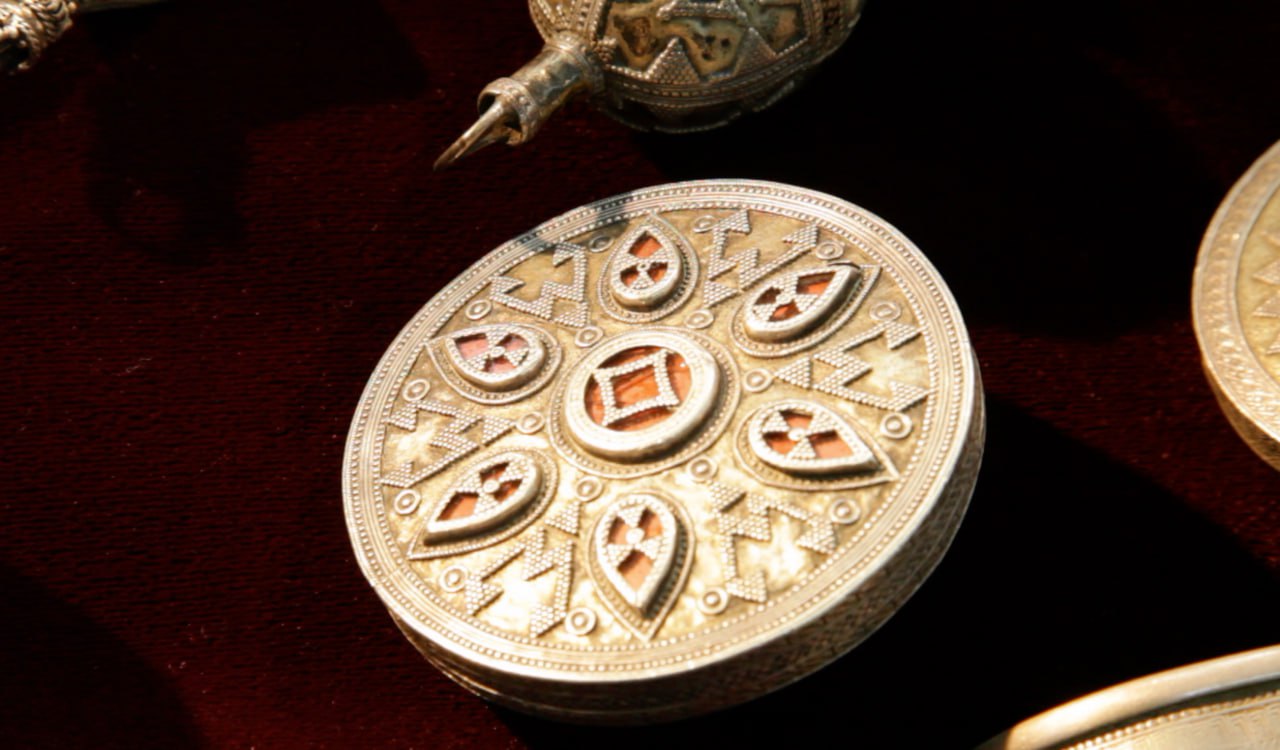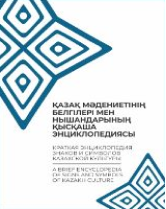
Jewellery and metal plastic works
As in the past, craftsmen now produce a huge range of items, of which women’s jewellery takes precedence. In the olden days, the craftsmen-zergers created metal parts for the decoration of clothing, shaped plaques for furniture, crockery, weapons and horse harness, as well as cutlery and other items.
Working with metals, Kazakh zergers have long used various semi-precious stones: topaz, pearls, diamond, ruby, crystal, carnelian, turquoise, mother-of-pearl and coral, which carried a great semantic load. At the same time, each of them has a specific meaning, if in one case it is interpreted as “giving” energy, in the other as “protecting” from evil forces. In the popular belief, the stone inserts are called köz (literally “eye”), which is interpreted as an all-seeing, protective eye.
In jewellery, experts note regional specifics. Products of Western Kazakhstan, Central, Northern and Eastern Kazakhstan, South Kazakhstan, Syrdarya and Zhetysu regions are distinguished.
The works of Western Kazakhstan occupy a special place in this series. They are distinguished by their solidity, large proportions and monumental artistic image. Local craftsmen master the manufacture of jewellery with low-relief embossing, applied filigree and graining, and black ornamentation. In addition, the technique of applied plates, which were soldered into a volumetric form, and the cavity was filled with mastic, has been widespread here since ancient times. The front side of such plates is richly decorated with engraving, grains and stones.
Today the revival of many technologies and techniques of manufacturing products in the Western Kazakhstan style is carried out by magnificent masters: Bolat Atraubayev, Utepkali Omirov, Sagidulla Orazov, Toremurat Omir, Kairat Shapabaev, Mukhtar Sherniyazov and others. Many of them come from familydynasties.
At the same time, it should be noted that craftsmen talk about some lost technologies. For example, the technology of making qazaq pyshağy (literally “Kazakh knife”) is considered to be forgotten. Practically all nomads once carried such knives, which were superior to bulat steel in their properties. The loss of some specific jewellery techniques has also been noted.
Jewellery of masters from Central, Northern and Eastern Kazakhstan is distinguished by its lighter form, proportionality of scale and colour saturation. Earlier in these regions inlaid, openwork filigree and niello jewellery were created, as well as engraved, embossed, stamped and cast jewellery.
Specialists believe that art metal from South Kazakhstan, Syrdarya and Zhetysu has a syncretic unity of various styles, formed under the influence of the cultural influences of the Great Silk Road.
In general, jewellery is classified according to its location on the body: head, ear, temple; studs, breast, shoulder; side, belt and hand jewellery.
Kazakhs have several complexes of female jewellery. The first of them includes head and temple jewellery. The complex of head jewellery includes saukele (traditional bride’s headdress), temple jewellery shekelik – pendants, shashbau, sholpy and earrings.
The wedding dress of a Kazakh bride was truly of royal splendour and consisted of a harmonious complex: headdress – saukele, temple pendants and earrings, necklace and breast adornment, bracelets and rings. Saukele in Kazakh culture has high semantic status, embodying the three-tier model of the world. The motif of goddess Umai in various degrees of stylization often varied in its decoration, and the elements of vegetal ornamentation and scatterings of grains on the adornments symbolized fertility. The best examples of Kazakh saukele are kept in the world’s best museums.
Today, the tradition of making Kazakh saukele is being continued by several masters, one of them being Serikkali Kokenov, a well-known Kazakh and foreign zerger.
In the past, shekelik temple ornaments were worn on ceremonial occasions. They were attached to the loops of the headdress or to the hair at the temple. Temple ornaments were mostly multi-piece, sometimes with pendants on long chains. The openwork and spherical shekelik with complex pendants, sprinkled with grains, looked spectacular.
Shashbau ornaments are richly ornamented ribbons. The ends of this jewellery are finished with lush silk tassels formed from cords or silver pendants. Shashbaus are fastened at the base of the braids and run down the length of the hair, and a variety of jewellery techniques were used in their decoration. They were exclusively worn by girls and were replaced by sholpy after marriage.
The most widespread type of shashbau was a peculiar openwork pendant with numerous plaques or coins connected vertically in one or three rows in a loop-shaped pattern. According to folk beliefs, such jewellery protects a girl’s hair, which contains her soul.
Earrings are the jewellery of a woman of any age, and are still regarded as the strongest amulets. The Kazakhs have many types and variants of earrings. The following types of earrings were distinguished: aishyqty syrğa – in the form of the month, ai syrğa – in the form of the moon, tūmarsha syrğa – earrings-amulets; salpyñshaqty syrğa – earrings with pendants; qozaly syrğa – earrings with pendants; tasty syrğa – earrings with a stone; qaraly syrğa – blackened earrings; iyiqty syrğa – shoulder-length earrings; koñirau syrğa – bell earrings; kümbezdi – dome-shaped earrings; soyau syrğa – pointed earrings.
There is a great variety in wrist jewellery. First of all, these are zhüzik -rings, which are particularly diverse in size, decoration and meaning. They were peculiar markers showing a woman’s status. For example, the qūstumsyq (bird’s beak) ring symbolized happiness, freedom and independence and was worn by young unmarried girls, while the ring of the bride – continuator of the family was called оtau zhüzik and symbolized the hearth and home. The ring worn on two fingers with two bars – qudaği zhüzik (matchmaker rings) symbolised the union of two families, clans.
The bracelet was usually worn alone or in pairs on both hands, sometimes two bracelets were put on one hand. Bracelets could be solid or compound: formed of 2-3 parts, connected by hinged method – topsaly bilezik or by means of cuff – qaqpak bilezik. There were also simply cast bracelets. In the decoration of bracelets stone inserts, applied filigree, grains, through-carving and relief embossing were used.
The next complex of Kazakh jewellery consists of breast ornaments. First of all, it is necessary to note önirzhiek, which is part of the festive jewellery complex, which was and still is the privilege of young women. This type of jewellery is exclusive to western Kazakhstan.
The design is vertical, consisting of large rectangular or trapezoidal plates decorated with grains, overlays, skins and ornamental ribbons.
Most often, önirzhiek were decorated with diamond-shaped ornaments, the symbol of fertility and prosperity. This jewellery is now very popular among girls and young women.
One of the most common types of chest jewellery is pieces of the tūmar and boytūmar type, silver cases of triangular, rectangular and tubular shape, hollowinside, suspended from the chest by chains and containing notes with quotations from the Koran. The main function of such jewels was to protect them from the evil’s eye. Their surface was richly decorated with engraving, nielloing and gilding, and pendants of coral, mother-of-pearl and metal plates were attached to the lower edge.
A separate complex consists of metal ornaments, designed to decorate elements of traditional Kazakh costume. These are three-dimensional and flat camisole clasps – qaptyrma and buttons – tüyme. The qaptyrma is usually made of two parts of the same shape, connected by two types of locks: a hook and loop or a latch-key. Buttons come in a variety of shapes.
Applied metal ornaments, usually plaques, were richly decorated on belbeu and kise belbeu – belts. The latter had all sorts of pendants for knives, flares, bullets, gunpowder and other items, which were also covered with patterned plaques.
This is the main range of Kazakh jewellery. The Kazakh jewellery art still demonstrates great potential, and the work of contemporary Kazakh craftsmen demonstrates the vitality of ancient traditions, which are evident in the composition, ornamental structure, techniques and technology.
The time marches on and brings technological innovations in the production process of metalwork, but still many renowned craftsmen favour the preservation, enrichment and further development of tradition.





